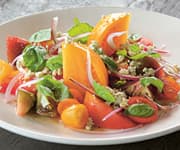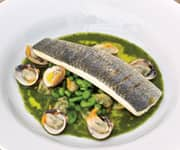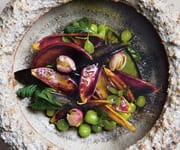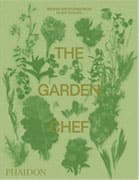Life Extension Magazine®
For many chefs, it’s not the recipes that dictate the ingredients; it’s the ingredients that inspire the recipes. In a growing trend, this inspiration is found just steps away from the kitchen, in the chefs’ very own gardens.
The Garden Chef cookbook highlights recipes from top chefs who are participating in “plot to plate,” a movement that focuses on growing and eating your own food.
Whether it’s on a sprawling country estate with fruit trees and vegetables, or a rooftop terrace with herbs and spices, growing their own ingredients allows these chefs to have menus as unique as the plants they’re growing—and as varied as the soil, climate, and space will allow.
With plot to plate—also called plant to plate—the focus becomes solely those plants that are in season. This provides not only a constantly changing menu, but also a healthier one, since seasonal eating has been shown to produce the healthiest microbiome.*
Of course, it simply tastes better, too.
The Garden Chef is more than just a cookbook. It is a peek into the signature recipes inspired by the kitchen gardens of 40 of the world’s best chefs. From Iceland to Russia, and Brazil to Australia, chefs from around the world share the stories of their personal garden experiences, along with a hand-picked selection of their own unique plot-to-plate recipes.
On the following pages, Life Extension® features four of these recipes, highlighting the simple fact that food can be just as beautiful as it is flavorful, and just as healthy as it is appetizing.
—Laurie Mathena
* Science. 25 Aug 2017.
Rooftop Heirloom Tomato and Basil Salad
SERVES 4

Vinaigrette
- best-quality extra-virgin olive oil
- best-quality Spanish sherry vinegar
Salad
- 900 g assorted heirloom tomatoes
- red onion, shaved, to taste
- 1 handful Opal basil leaves
- 1 handful Genovese basil leaves
- 50 g domestic blue cheese crumbles
(Point Reyes or Maytag) - sea salt and cracked black pepper
Vinaigrette: Put the oil and vinegar into a squeeze bottle and shake it vigorously.
Salad: Cut any small tomatoes in half and big ones into wedges (removing the core).
To Serve: Arrange the tomatoes on 4 plates or a large platter. Sprinkle with shaved red onion. Next, place both types of basil on top, tearing large leaves but leaving small leaves whole. Dress the salad with the vinaigrette, season with salt and pepper, and sprinkle with the blue cheese crumbles.
Minted Pea Soup with Goosefoot
SERVES 4–6 AS AN APPETIZER
- 1 tablespoon butter
- 1 clove garlic, minced
- 1 shallot, minced
- 2 tablespoons white rice
- 120 g onion, diced
- 750 ml water (or chicken broth if you prefer)
- 270 g fresh or frozen peas
- 175 g wild goosefoot (Chenopodium berlandieri), coarsely chopped
- 1 tablespoon mint leaves, coarsely chopped
- juice of 1 lemon
- salt and freshly ground black pepper
Put the butter, garlic, and shallot in a soup pot over medium heat and sauté for 2–3 minutes until fragrant. Add the rice and onion and cook for another 5 minutes until the onion softens, then add the water (or chicken broth) and simmer for 15 minutes, until the rice is cooked.
Remove the pot from the heat and add 1 teaspoon of salt, a dash of black pepper, the peas, goosefoot, mint, and lemon juice.
Carefully blend with an immersion (stick) blender until smooth. If you’re serving the soup hot, you may need to reheat it. If you’re serving it chilled, let cool, then refrigerate for at least 2 hours.
Steamed Bass with Cockles and Summer Pistou
SERVES 4, AS PART OF A TASTING MENU

- 4 x 125 g fillets wild bass, skin scored
(increase the size to 200 g portions for
larger main-course size) - 500 g cockles in their shells, well washed
- 12 thick asparagus spears, trimmed, tips removed,
and stems sliced into thin rondels - 2 tablespoons fresh peas
- 2 tablespoons shelled fava (broad) beans
- Sea salt
- SUMMER PISTOU
- handful of basil leaves
- 1 tablespoon grated Parmesan cheese
- 1 tablespoon olive oil
- TO SERVE
- squeeze of lemon juice
- drizzle of light Ligurian or Provençal olive oil
Season the fish fillets with salt, wrap them tightly in plastic wrap (clingfilm), and refrigerate for 2 hours to set the shape. Take out of the refrigerator 15 minutes before cooking.
Put a pan onto medium heat and throw in the cockles. Cover and cook for 3 minutes, or until the shells have opened. Shake the pan from time to time to help the process. Let the cockles cool in the pan, then strain the juice and reserve. Remove almost all the cockle meat from the shells (keep a few to decorate) and reserve.
SUMMER PISTOU: Combine the pistou ingredients in a mortar and pound to a paste. Alternatively, use a mini food processor.
Sit the fish fillets on a plate (still in their wrapping) and set in a colander over a pan of simmering water. Cover and steam for around 5 minutes, then check the internal temperature with a probe thermometer. When it reaches 110ºF/45ºC remove from the heat and let rest in a warm place; it will increase to just under 120ºF/50ºC with the residual heat.
While the fish is resting, heat the reserved cockle juice in a small pan. Add the asparagus rondels, peas, and fava (broad) beans and cook for 2–3 minutes, adding a tablespoon of water if needed.
Meanwhile, heat a little water in a small frying pan or skillet and simmer the asparagus tips for 2 minutes. Drain and add to the pan with the rest of the vegetables. Stir in the pistou, add the cockles, and warm briefly.
TO SERVE: Divide the vegetables and cockles among 4 warm serving bowls. Dress the fish fillets with a little lemon juice and olive oil. Place on top of the cockle pistou and season. Decorate with the reserved cockles in their shells and serve immediately.
Lamborn Peas, Green Miso, Lemon
SERVES 2

- 16 Lamborn snap pea pods
- 2 teaspoons Korean green soybean miso paste
(doenjang) or other high-quality miso - 4 teaspoons softened unsalted butter
- pinch of dehydrated anchovy sauce
- grated zest of 1/2 lemon
- 24 red speckled snow peas (mangetout), trimmed
- 8 Lamborn pea shoots
- 4 teaspoons extra-virgin olive oil
- 12 red speckled snow pea flowers
Shell the Lamborn snap pea pods. Blanch the peas in a pan of boiling water for 10 seconds, then remove and refresh in a bowl of ice water.
Mix the miso paste, butter, anchovy sauce, and lemon zest together in a bowl, then spread out on 2 serving plates.

Place the blanched peas on top of the miso, dress the snow peas (mangetout) and pea shoots in the extra-virgin olive oil, then place them on top of the peas and miso. Garnish with the red speckled snow pea flowers and serve.
If you have any questions on the scientific content of this article, please call a Life Extension® Wellness Specialist at 1-866-864-3027.
Reprinted from The Garden Chef (Phaidon 2019).
To order a copy of The Garden Chef, call 1-800-544-4440 or visit.

